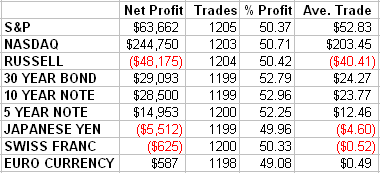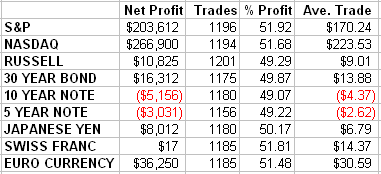Yesterday, we showed the following results for buying on the opening, selling on the close following a close higher than the previous 40-day closing average (and vice versa following closes under the average). As always, we're talking symmetrical methodology.

Today's either-or open-to-close technique involves a variation on the averages/ranges. The theory or market "driver" behind it is that pure momentum works better following lower ranges (consolidation) and "fade" ideas work better following higher ranges (expansion). As usual, this is not a concept I created out of thin air. Many mechanical proponents acknowledge it.
Trust that the usual optimization/analysis has been done, resulting in the following:

In English, if today's range is less than the average 10-day range (including today's), then buy the open if today's close was higher than yesterday, or sell short the open if the close was lower. If the range was greater than the 10-range average, you fade the direction of the close â€" buy if it was lower, sell if it was higher.
TradeStation Easy Language follows:
inputs: pp(10);
if range>average(range,pp) and c<c[1] then buy next bar at market;
if range<=average(range,pp) and c<c[1] then sell short next bar at market;
setexitonclose;
Art Collins is the author of Market Beaters, a collection of interviews with renowned mechanical traders. He is currently working on a second volume. E-mail Art at artcollins@ameritech.net.